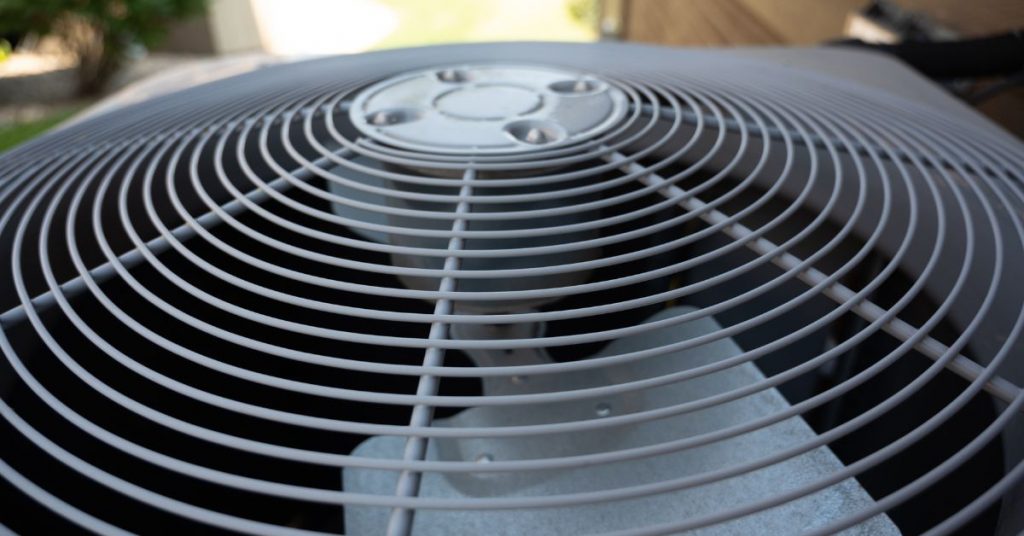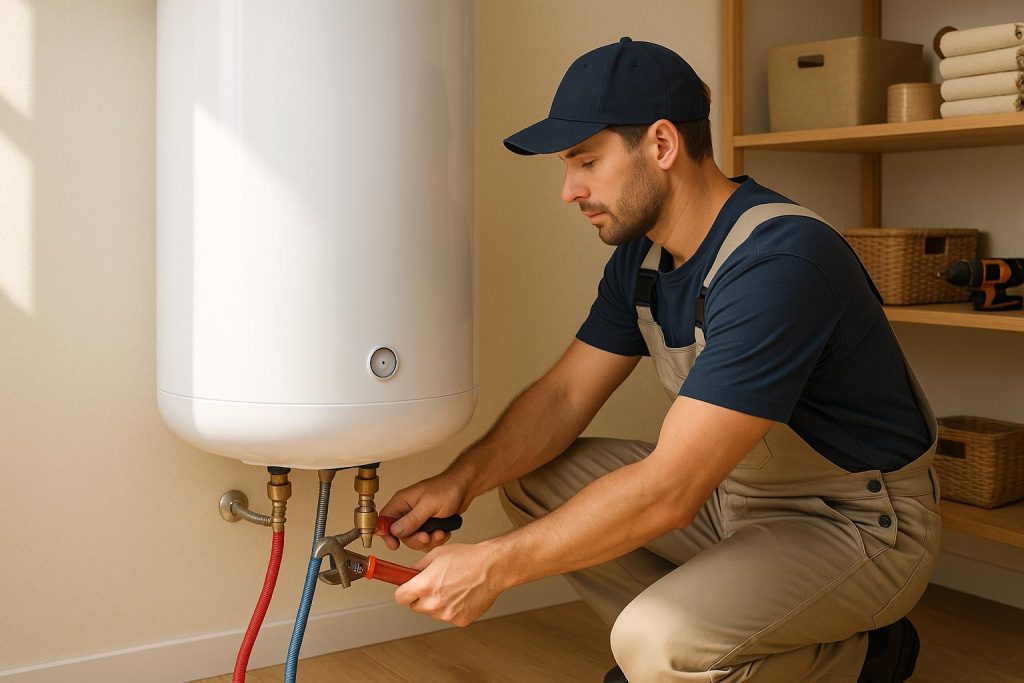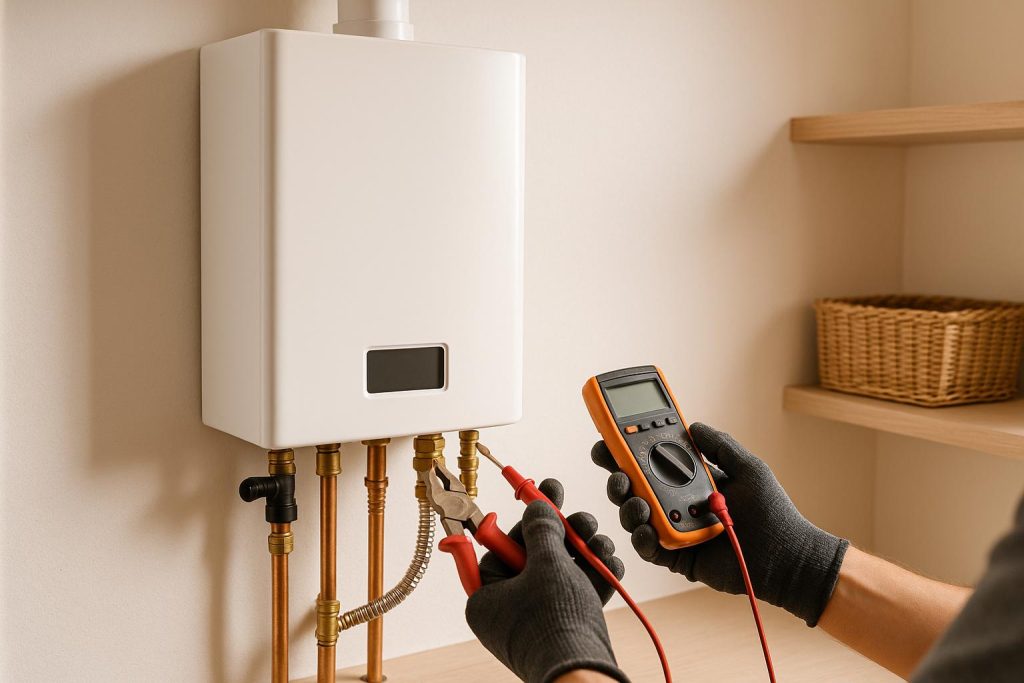
In most cases, your AC motor will fail to spin because of a failed capacitor. It could also be due to a burnout fan motor, dirty motor axle, tripped circuit breaker, bad contactor, slipped/broken fan belts or restricted airflow to the unit.
Common Causes
- Faulty Capacitor: A malfunctioning fan capacitor can prevent the fan motor from starting or running correctly.
- Motor Issues: Problems with the fan motor, such as a burned-out motor or damaged bearings, can result in the fan not spinning.
- Electrical Problems: Wiring issues, damaged electrical connections, or a faulty fan relay can disrupt the electrical supply to the fan motor.
- Thermostat Problems: Incorrect thermostat settings or a faulty thermostat can lead to the fan not receiving the signal to operate.
- Blocked or Stuck Fan Blades: Debris or physical obstructions in the fan blades can prevent them from spinning freely.
- Tripped Safety Switch: Safety mechanisms, like the float switch in the condensate drain, can shut off the fan if there’s an issue with drainage.
What to Do
- Safety First: Turn off the power supply to the AC unit at the circuit breaker or disconnect switch to avoid electrical hazards while troubleshooting or performing maintenance.
- Check the Thermostat: Ensure that the thermostat is set to “cool” mode and the desired temperature. Test the thermostat by lowering the temperature setting to see if the fan responds.
- Inspect the Capacitor: Examine the fan capacitor for signs of damage or swelling. A faulty capacitor can be replaced by an HVAC technician.
- Examine the Motor: Inspect the fan motor for visible damage or overheating. If you suspect motor issues, consult a professional technician to assess and replace the motor if necessary.
- Check Electrical Connections: Ensure all electrical connections are secure and free from damage. Replace any faulty wiring or connectors.
- Clean Fan Blades: If debris or obstructions are preventing the fan blades from spinning, carefully remove the blockage and clean the blades.
- Reset Safety Switches: If applicable, check safety switches like the float switch in the condensate drain for proper operation and reset them if needed.
- Test the Fan: After addressing potential issues, turn the power back on and test the fan to see if it starts spinning. If it still doesn’t work, consult a professional HVAC technician for a thorough diagnosis and repair.
Troubleshooting an AC Fan That is Not Spinning
If you have an AC fan that is not spinning, you should mainly focus on 3 things:
- Circuit breaker
- Capacitor
- Fan motor
Check if the circuit breaker has tripped, if the fan is not spinning and the outside unit is not humming/buzzing as well. That usually signifies that the unit is not being supplied with power.
If the outside unit is running but the fan is not spinning, either you have a bad capacitor or faulty fan motor. Grab a screwdriver or long thin stick and try to manually turn the fan.
Turn one of the fan blades clockwise and withdraw the stick immediately. If the fan kicks in immediately and starts to spin normally, you are dealing with a bad capacitor.
What this test shows is that the capacitor is unable to supply the motor with the startup torque needed. By manually, turning the fan, you have temporarily replaced the capacitor.
Note: It is a bad idea to continue using the air conditioner with a bad capacitor. It overworks the motor which not only increases energy bills but it can also cause the motor windings to overheat and ultimately burnout.
If after manually turning the fan it did not kick in but instead it came to a stop after a few seconds, you most likely have a bad fan motor. However, if the fan does not spin with ease, it is possible that the fan is being impeded by dirt/debris in the axle or motor bearings.
How to Fix an AC Fan That Is Not Spinning
The first thing as I mentioned is to troubleshoot your air conditioner and find out why the fan is not spinning. The solution will depend on the source of the problem.
Let us look at several ways to fix an air conditioner whose fan is not spinning. The following are some of the ways to get your AC fan spinning again:
1. Check If the Circuit Breaker Has Tripped

Air conditioners are designed in such a way that if the motors are overloaded/overworked, the circuit breaker will trip, effectively turning off power supply to the AC unit.
That allows the motor to cool off and therefore avoid overheating which causes the motor to burn out. If you outside unit is not even buzzing/humming, it is a sign that it is not receiving power.
The first thing you should do is dash to where your main breaker panel is and look for the breaker labeled “Air Conditioner” or simple “AC). If it has tripped, the breaker will be in the down position.
All you will have to do is flip it in the “ON” position and that should fix your problem. Circuit breakers trip for different reasons so you should try and find out why it tripped in the first place. You could be dealing with dirty filters, clogged coils, blocked ducts or even leaking refrigerant among other issues.
2. Replace Bad Capacitor

Most of the time when your AC fan is not spinning, a bad capacity is usually the cause. When a capacitor fails, it loses its ability to store charge and it therefore fails to power up the motor.
An AC capacitor is a cylindrical or oval component located inside the outside unit, concealed by the cover panel. Capacitors store a high electric charge which they release to power up the motor during startup. They also help the motors to run smoothly and efficiently.
There are start and run capacitors. Start capacitors power up the motors during startup and then disconnects from the circuit while run motors maintain the delivery of sufficient current to the motors during the cooling cycle.
Most AC units however only have run capacitors which carry out both of these functions. To ascertain that the reason your AC fan is not spinning is due to a bad capacitor, you will need to test the AC’s capacitance (ability to store charge) using a multimeter.
Depending on the type of unit you have, you may have 2 single run capacitors (one for compressor and the other for fan) or a dual run capacitor which serves both the fan and compressor. Single run capacitors have 2 terminals while dual run capacitors have 3 terminals and 2 capacitance ratings.
Capacitors have their capacitance rating clearly displayed, but will also give you a range (usually +/- 6%). That means that you should get between 94% and 106% of the given microfarads (capacitance) after testing.
How to Test an AC Capacitor’s Capacitance
- Start by turning off power to the AC unit at the breaker box or inside your house from the main breaker panel.
- Turn off the thermostat as well.
- Use a screwdriver to remove the cover panel and place it away. You can now see the capacitor and the contactor.
- Does the capacitor look bad visually? If the capacitor is swollen (usually at the top) or it is leaking out a fluid, it is clearly bad and you don’t even need to test it.
- Discharge the capacitor. You can use a screwdriver with an insulated handle for that. Wear insulated gloves as well. If you have single run capacitor, use the metal part of the screwdriver to short-circuit the 2 capacitor terminals. For dual run capacitor short the common “C” terminal and HERM and then common and FAN.
- Set your multimeter to the capacitance (MFD/uF) setting.
- If you have a single run capacitor, place the 2 probes on the 2 terminals and note down the capacitance reading.

- With a dual run capacitor, place the probes on “C” and HERM and note down the readings and then “C” and FAN terminals and note down the readings as well.
In dual run capacitor, the capacitance is usually given in something like 45/5 uF. It is important to know that the high value is for the compressor (HERM) while the lower reading is for the fan.
It is however not unusual to find out that the compressor side of the capacitor is good while the fan side is bad or vice versa. You will still need to replace the capacitor despite one side being good.
If you have 2 single run capacitors and you have found out that the fan motor capacitor is bad, it is best to replace both of the capacitors or even replace them with a dual run capacitor since it is matter of time before the other one fails as well.
How to Replace AC Capacitor
If you have come to the conclusion that the capacitor is bad, make sure that you replace it with another one of the same rating. By same, I mean capacitance and voltage rating. That is very important otherwise your AC may not work or will operate out of balance.
- Before disconnecting the bad capacitor, take picture of all the connections so that you connect the new capacitor the exact same way.
- Disconnect the wires and also undo the strap connecting it to the unit.
- Install the new capacitor the same way you removed the old one.
- Put back the cover panel
- Turn on the power to the AC and also the thermostat as well.
3. Check the Fan Motor

If it looks like you are dealing with a bad fan motor, it is hardly something you can fix on your own. That is the kind of repair that will need to be carried out by a professional HVAC technician.
After years of usage, the AC fan motor will fail due to wear and tear and a replacement is the only option. Sometimes the fan may not have failed but debris could have jammed the fan axle or motor bearings, preventing the fan from spinning.
Although you can try checking and cleaning out the debris, I would recommend having a technician coming over and doing the job professionally.
Another problem that can emanate from your fan motor is broken or slipped fan belt. While new AC units use bearings, if you have an old AC unit chances are high that it uses a fan belt. These belts can break or even slip out.
Problems associated with fan motor belts are easy to fix on your own and are also inexpensive. If the belt has slipped out, you will only need to put it back but if it is broken you will need to buy a similar one and replace it. To do this repairs first make sure that power to the unit is turned off.
So, how can you be really sure that your AC fan motor has burnt out? The only way to do that is by testing the motor itself.
Again, you will need to remove the outside AC unit side panel in order to access the wires connected to the fan motor.
Since there are many wires on the side of your unit, it is not easy to tell which wires are connected to the fan motor. Check if there is a wire schematic on the back of the cover panel which will let you know which of your wires are connected to the fan motor.
If there is no schematic, you can manual trace the 3 wires. Before disconnecting the wires, it is better to take a picture of the whole set up so that you will know which wire was connected where when putting them back.
Check out the below video for more clarity on the same issue.
4. Test the Contactor
A contactor is a magnetic switch located next to the capacitor with wires coming in and out of it. It is controlled by the thermostat.
The contactor as you can imagine from its name has a plunger which closes and opens to allow power to flow to the unit or cut it off. It short, it makes or breaks contact with unit’s electrical circuit as demanded by the thermostat.
When the thermostat calls for cooling, 24 volts are sent to the contactor coil, magnetization happens and the plunger is pulled in thereby completing the circuit. After the cooling cycle, the 24 volts of current is withdrawn and the plunger disconnects.

Although it rarely happens normal wear and tear can prevent the contactor from working as designed, meaning that power will not flow to the AC outside. Bugs can also prevent the plunger from moving, but those can be cleaned out.
But how can you tell that your air conditioner contactor is bad? You will need to measure the resistance between the 2 contactor terminals using a multimeter.
Before working on your contactor, make sure that you have turned off power to the air conditioner and also turned off the thermostat.
Start by disconnecting the wires connected to the contactor. Make sure that you first take a picture of all the connections so that you can figure out which wire goes where when putting them back.
Take out the contactor and locate the 2 terminals on each side of its coil. Set your multimeter to resistance and place one probe on one terminal and the other probe on the other terminal.
For a good contactor, you should get a resistance reading of between 12 and 27 ohms. If you a very high value or even a lower one, you definitely have a bad contactor.
Luckily, AC contactors are cheap (usually between 10 and 20 dollars). The problem is that not everyone can test or even replace them and HVAC technicians will charge a lot to do it.
Preventing AC Fan Problems
Most of the times, capacitors and AC motors fail due to overheating. Overheating in AC means that the components are being forced to work harder than they should.
One of the main causes of that is restriction of airflow in the AC system. If for instance you fail to change your AC filter after every 3 months or the evaporator coils are dirty, the system will have to worker harder in order to cool the house, which means working for longer periods of time.
Blocked or leaking air ducts or even low levels of refrigerant can also cause the AC system to overwork and components to overheat. It is always important to have an HVAC technician come over to your place (especially just before summer) to service your AC system so that it doesn’t fail when you need it most.
HVAC services are expensive but trust me you would rather pay for preventative services than having to replace a blown out fan motor.





